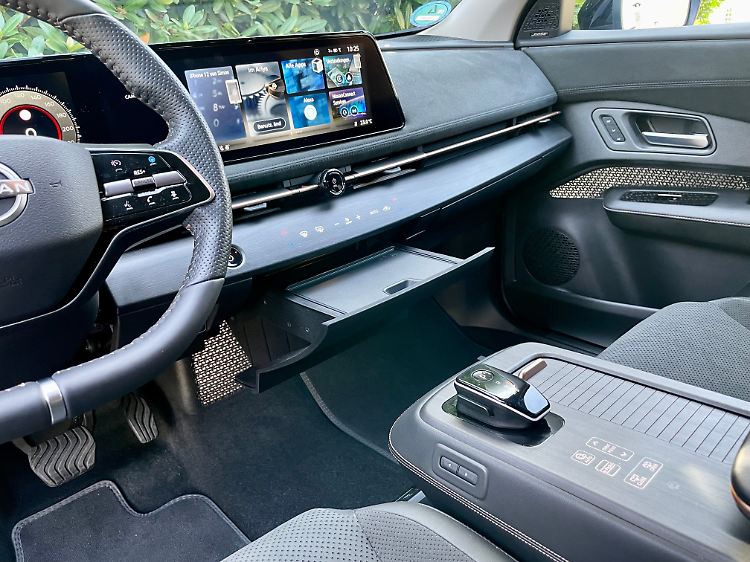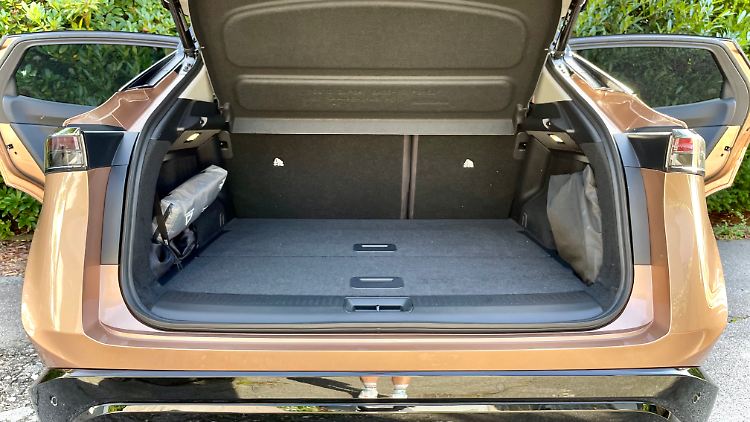With the Ariya, Nissan is bringing an extremely comfortable BEV representative. It also offers a bit of chic and a lot of comfort. ntv.de was traveling with the silent Japanese. In the version with all-wheel drive and lots of power.
Have you ever seen a Nissan Ariya? Most readers probably don’t – and that’s a shame. Because the model, which thrives in secret and which somehow only a few people get wind of, definitely deserves more. The Federal Motor Transport Authority only counted 841 registered copies as of October this year. The Ariya looks neat. Not exaggerated like some other Japanese, but also anything but boring.


The front looks striking with the black shield. Why is there no matrix technology behind the strikingly narrow headlight surrounds?
(Photo: Patrick Broich)
The expressive front with the deep black shield is particularly eye-catching. And the technoid-looking headlights with their optically refined LED segments (adaptive matrix light is missing, however). The Ariya even looks a bit fancy in the so-called communication color “Akatsuki Copper” together with the roof in black contrasting paint. And extremely solid with its emphatically high waistline.
Comfortable and homely


Alcantara and wood make the interior elegant, even if the large display complex is not quite as stylishly curved.
(Photo: Patrick Broich)
But the real surprise only comes after boarding the crossover: the seats found here with a type of microfiber as an upholstery surface are so comfortable that you don’t want to get out. There is also a homely atmosphere in the young Nissan. Elegant black wood applications harmonize with Japanese Kumiko patterns, which run like a common thread through the entire car and are not only found in the area of the door coverings. Even the covers of the loudspeaker boxes are presented in this special scheme.


What is the side switch for please? Yes, the center console, which has elegant decorative stitching, is electrically adjustable.
(Photo: Patrick Broich)
Copper-colored strips in the ventilation nozzles as well as elements throughout the vehicle (for example as a handle for the small blind in the compartment in the middle) exude a touch of exclusivity. This also applies to the upper area of the inside of the door and the entire dashboard, which has a type of Alcantara. And thanks to the free-standing center console, the Ariya leaves an airy impression without any confinement. As a little gag, the console with leather armrest can be electrically adjusted.
In general, the interior is full of gadgets, even if they are not always entirely practical. Controls for the automatic air conditioning can be found as buttons embedded in the wooden decor. When touched, there is haptic feedback and the symbols become brighter. This looks cool, but isn’t as functional as the conventional physical button. And because Nissan knows this very well, the company has at least provided a classic rotary control for volume control. Successful compromise! What’s less successful is that there isn’t a particularly large trunk behind the electric tailgate (1280 liters).
In many variations


Compared to other parts of the vehicle, the rear is less exciting. But also pleasing.
(Photo: Patrick Broich)
Slowly I feel like going for a ride with the Japanese guy. Here and today ntv.de is on the road with the all-wheel drive version – not exactly a cheap pleasure considering a basic price of 57,490 euros. Sure, a lot is offered for the value, but such a chunk of money reduces the customer price. To be fair, however, it has to be said that the middle class has generally become expensive. So this is not something specific to Ariya.
After all, the basic model is available at a price starting at 43,490 euros, which is not exactly popular pricing either. And in this case, the performance is not only lower at 218 instead of 306 hp (although it is still quite high), but the battery is also significantly smaller at 63 instead of 87 kWh. On the other hand, less battery capacity is also more environmentally friendly. But more on the battery issue later.


The space in the rear is fairly generous.
(Photo: Patrick Broich)
The dual motor drive is without a doubt a delight. It’s not that the 306 little horses encourage racing, but they make the 4.60 meter long middle grader incredibly confident. Pressing the accelerator pedal allows the 2.3-ton truck to rush forward in any situation. No wonder when a concentrated 600 Newton meters of torque attack. In addition, there are never any interruptions in traction – after all, there is no change gear and therefore no clutches that have to be opened and closed again. This pays into the agility account.
Please don’t be alarmed when you look at the data sheet – the Nissan reaches 100 km/h in 5.7 seconds according to the factory. The passengers feel this value under full load in the back of their backs in the form of a massive push. Of course, there are no traction problems thanks to two driven axles. And the Japanese don’t compromise on the top speed, allowing 200 km/h – that’s a respectable number for a middle class that’s not fundamentally focused on performance.
Nissan doesn’t shine when it comes to charging


While the interior is airy, the cargo space has to take a back seat. But the Ariya sees itself more as a lifestyler than a hardware store carriage.
(Photo: Patrick Broich)
This Japanese guy is clearly playing the comfort card. Its chassis also appears balanced and smooths out bumps fairly effectively. Nissan does not use variable damper control, nor does it need one – after all, harmonious coordination is enough. Accordingly, the Ariya is the casual tourer – predestined for long journeys. Provided you get involved in the charging issue. Nissan promises a combined WLTP range of up to 513 kilometers (at 19.8 kWh/100 km).
That’s okay, but a crucial factor is of course the loading speed. The Ariya has a nominal peak charging power of 130 kilowatts. Quite honestly, there has to be more possible today, also given the pricing. If things are going well, i.e. the electricity storage is at a good temperature and the charging station is optimally selected, you can charge almost 200 kilometers within 20 minutes. Here the travel planning must be adjusted accordingly. Anyone who knows about this fact can live with it. However, many customers will soon no longer be satisfied with this.
And if you’re going to wait at the charging station, you should at least take the opportunity to interact with the stylish display landscape. In order to figure out all the tricks, a certain learning phase is required. There are, after all, many menus to explore. For anxious people, the (standard) navigation system offers integrated charging planning when entering a far away destination. However, it has to be said that the fast charging network in this country has now become so dense that dedicated charging planning is almost no longer necessary.
Finally, a look at the driver assistance, which the designer vehicle has plenty of. All variants can actively accelerate, brake and steer – sometimes even aggressively. The most annoying functions, such as controlled lane guidance, can of course be switched off, although not via a shortcut – the NCAP Crash Commission does not approve of something like that. Let’s see how long customers will continue to appreciate the NCAP organization.
Data sheet Nissan Ariya e-4ORCE all-wheel drive
|
Dimensions (length/width/height) |
4.60 / 1.85 / 1.65 m |
|
wheelbase |
2.78m |
|
Empty weight (DIN) |
2259kg |
|
Seating |
5 |
|
loading volume |
415 to 1280 l |
|
Engine type |
Two electric machines |
|
transmission |
A translation, solid |
|
System performance |
306 hp (225 kW) |
|
drive |
all wheel drive |
|
Max. Torque |
600 Nm |
|
Acceleration 0-100 km/h |
5.7s |
|
Top speed |
200 km/h |
|
Battery capacity |
87 kWh (net) |
|
Maximum charging power (direct current) |
130kW |
|
Charging power (alternating current) |
Maximum 22 kW |
|
Consumption (combined) |
19.8 to 20.4 kWh/100 km (WLTP) |
|
combined WLTP range |
498 to 513 km |
|
Combined CO₂ emissions |
0g/km |
|
Basic price |
From 57,490 euros |
Conclusion: The Nissan Ariya is a very successful vehicle with a purely electric drive. With its mix of neat looks and a particularly comfortable feel, it should have the potential to attract many customers. However, this is currently only happening with moderate success. But why is that? The name that is difficult to write? Or because of the somewhat weak charging performance compared to today’s standards? There’s actually no reason to deny the attractive overall package its chance. This should be understood as an appeal. So please be sure to book a test drive!
































